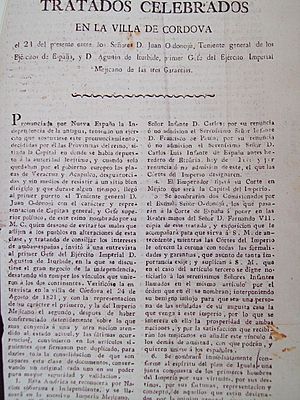Treaty of Córdoba facts for kids
 |
|
| Signed | 24 August 1821 |
|---|---|
| Location | Córdoba, Veracruz, Mexico |
| Condition | The treaty was rejected by Spain. |
| Signatories | |
| Ratifiers |
|
| Language | Spanish |
The Treaty of Córdoba was a very important agreement. It officially made Mexico independent from Spain. This happened at the end of the Mexican War of Independence.
The treaty was signed on August 24, 1821. The signing took place in Córdoba, Veracruz, which is in Mexico. The main people who signed it were Agustín de Iturbide and Juan O'Donojú. Iturbide led the Mexican army, called the Army of the Three Guarantees. O'Donojú was a Spanish official in Mexico.
This treaty had 17 articles, or sections. These sections built upon ideas from an earlier plan called the Plan of Iguala. The Treaty of Córdoba was the first document where both Spanish and Mexican officials agreed that Mexico should be free. However, Spain later rejected the treaty.
What the Treaty Wanted
The treaty said that New Spain, which is now Mexico, would become an independent empire. It described this new empire as a "monarchical, constitutional and moderate" government. This means it would have a king or emperor, follow a set of laws (a constitution), and be fair.
The treaty first offered the crown of Mexico to Ferdinand VII of Spain. He was the king of Spain at the time. If he did not come to Mexico to become emperor, the crown would be offered to his brothers. These were Carlos and Francisco. It could also go to his cousin, Archduke Charles. If none of these royal family members accepted, the Mexican parliament, called the Cortes, could choose another person.
This last part was a new idea not in the Plan of Iguala. Iturbide added it so he might have a chance to become emperor himself. O'Donojú, the Spanish official, did not have the power to sign such a treaty. He probably signed it hoping to keep Mexico connected to the Spanish royal family. He might not have realized Iturbide wanted the crown for himself.
Signing and What Happened Next
On September 27, 1821, the Army of the Three Guarantees marched into Mexico City. The next day, Mexico's independence was officially announced. This was called the Declaration of Independence of the Mexican Empire.
Iturbide first tried to get a member of the Spanish royal family to be Mexico's emperor. But all these attempts failed. So, the Mexican Congress chose a Mexican to be the emperor the next year. On May 18, 1822, Iturbide was declared the Emperor of Mexico.
His rule as emperor lasted only three years. After a revolution called the Plan of Casa Mata, the Congress decided that the Plan of Iguala and the Treaty of Córdoba were no longer valid.
See also
 In Spanish: Tratados de Córdoba para niños
In Spanish: Tratados de Córdoba para niños
- Adams–Onís Treaty, a treaty from 1819 between the U.S. and Spain about borders
- List of treaties


